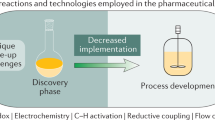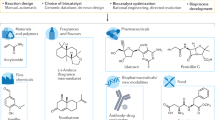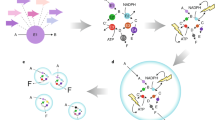Abstract
Enzyme cascades are a powerful technology to develop environmentally friendly and cost-effective synthetic processes to manufacture drugs, as they couple different biotransformations in sequential reactions to synthesize the product. These biocatalytic tools can address two key parameters for the pharmaceutical industry: an improved selectivity of synthetic reactions and a reduction of potential hazards by using biocompatible catalysts, which can be produced from sustainable sources, which are biodegradable and, generally, non-toxic. Here we outline a broad variety of enzyme cascades used either in vivo (whole cells) or in vitro (purified enzymes) to specifically target pharmaceutically relevant molecules, from simple building blocks to complex drugs. We also discuss the advantages and requirements of multistep enzyme cascades and their combination with chemical catalysts through a series of reported examples. Finally, we examine the efficiency of enzyme cascades and how they can be further improved by enzyme engineering, process intensification in flow reactors and/or enzyme immobilization to meet all the industrial requirements.

This is a preview of subscription content, access via your institution
Access options
Access Nature and 54 other Nature Portfolio journals
Get Nature+, our best-value online-access subscription
$29.99 / 30 days
cancel any time
Subscribe to this journal
Receive 12 print issues and online access
$259.00 per year
only $21.58 per issue
Buy this article
- Purchase on Springer Link
- Instant access to full article PDF
Prices may be subject to local taxes which are calculated during checkout






Similar content being viewed by others
References
Pharmaceuticals market to reach USD1,310.0 billion in 2020; eruption of the COVID-19 pandemic to accelerate the demand for effective treatments and drugs worldwide GlobeNewswire https://go.nature.com/3LdrZYh (2020).
Vincent Rajkumar, S. The high cost of prescription drugs: causes and solutions. Blood Cancer J. 10, 71 (2020).
Moors, E. H. M., Cohen, A. F. & Schellekens, H. Towards a sustainable system of drug development. Drug Discov. Today 19, 1711–1720 (2014).
Dunn, P. J., Wells, A. S. & Williams, M. T. Green Chemistry in the Pharmaceuticals Industry (Wiley, 2010).
Jarvis, E. A. A. Green chemistry in United States science policy. Green Chem. Lett. Rev. 12, 161–167 (2019).
Kumar, R., Martinez, C., Martin, V. & Wong, J. in Green Biocatalysis (ed. Patel, R. N.) 165–178 (John Wiley & Sons, Inc, 2016).
Sheldon, R. A. in Green Biocatalysis (ed. Patel, R. N.) 1–15 (John Wiley & Sons, Inc, 2016).
Truppo, M. D. Biocatalysis in the pharmaceutical industry: the need for speed. ACS Med. Chem. Lett. 8, 476–480 (2017).
Winkler, C. K., Schrittwieser, J. H. & Kroutil, W. Power of biocatalysis for organic synthesis. ACS Cent. Sci. 7, 55–71 (2021).
Sheldon, R. A. & Woodley, J. M. Role of biocatalysis in sustainable chemistry. Chem. Rev. 118, 801–838 (2018).
Chapman, J., Ismail, A. E. & Dinu, C. Z. Industrial applications of enzymes: recent advances, techniques, and outlooks. Catalysts 8, 20–29 (2018).
Mazurenko, S., Prokop, Z. & Damborsky, J. Machine learning in enzyme engineering. ACS Catal. 10, 1210–1223 (2020).
Bunzel, H. A., Garrabou, X., Pott, M. & Hilvert, D. Speeding up enzyme discovery and engineering with ultrahigh-throughput methods. Curr. Opin. Struct. Biol. 48, 149–156 (2018).
Köhler, V. & Turner, N. J. Artificial concurrent catalytic processes involving enzymes. Chem. Commun. 51, 450–464 (2015).
Zhang, Y. & Hess, H. Toward rational design of high-efficiency enzyme cascades. ACS Catal. 7, 6018–6027 (2017).
Birmingham, W. R. & Turner, N. J. A single enzyme oxidative ‘cascade’ via a dual-functional galactose oxidase. ACS Catal. 8, 4025–4032 (2018).
Lubberink, M. et al. Biocatalytic monoacylation of symmetrical diamines and its application to the synthesis of pharmaceutically relevant amides. ACS Catal. 10, 10005–10009 (2020).
Roura Padrosa, D., Benítez-Mateos, A. I., Calvey, L. & Paradisi, F. Cell-free biocatalytic syntheses of l-pipecolic acid: a dual strategy approach and process intensification in flow. Green Chem. 22, 3229–3238 (2020).
Lichman, B. R. et al. One-pot triangular chemoenzymatic cascades for the syntheses of chiral alkaloids from dopamine. Green Chem. 17, 852–855 (2015).
Özgen, F. F., Runda, M. E. & Schmidt, S. Photo-biocatalytic cascades: combining chemical and enzymatic transformations fueled by light. ChemBioChem 22, 790–806 (2021).
Schmermund, L. et al. Photo-biocatalysis: biotransformations in the presence of light. ACS Catal. 9, 4115–4144 (2019).
Cannalire, R. et al. Visible light photocatalysis in the late-stage functionalization of pharmaceutically relevant compounds. Chem. Soc. Rev. 50, 866–897 (2021).
Sun, H., Zhang, H., Ang, E. L. & Zhao, H. Biocatalysis for the synthesis of pharmaceuticals and pharmaceutical intermediates. Bioorganic Med. Chem. 26, 1275–1284 (2018).
Fischer, T. & Pietruszka, J. In Natural Products via Enzymatic Reactions (ed. Piel, J.) 1–43 (Springer, 2010).
Ramsden, J. I., Cosgrove, S. C. & Turner, N. J. Is it time for biocatalysis in fragment-based drug discovery? Chem. Sci. 11, 11104–11112 (2020).
Kulesa, A., Kehe, J., Hurtado, J. E., Tawde, P. & Blainey, P. C. Combinatorial drug discovery in nanoliter droplets. Proc. Natl Acad. Sci. USA 115, 6685–6690 (2018).
Schwarz, J., Rosenthal, K., Snajdrova, R., Kittelmann, M. & Lütz, S. The development of biocatalysis as a tool for drug discovery. Chimia 74, 368–377 (2020).
Truppo, M. D., Rozzell, J. D., Moore, J. C. & Turner, N. J. Rapid screening and scale-up of transaminase catalysed reactions. Org. Biomol. Chem. 7, 395–398 (2009).
Slabu, I., Galman, J. L., Lloyd, R. C. & Turner, N. J. Discovery, engineering, and synthetic application of transaminase biocatalysts. ACS Catal. 7, 8263–8284 (2017).
Kelly, S. A. et al. Application of ω-transaminases in the pharmaceutical industry. Chem. Rev. 118, 349–367 (2018).
Adams, J. P., Brown, M. J. B., Diaz-Rodriguez, A., Lloyd, R. C. & Roiban, G. D. Biocatalysis: a pharma perspective. Adv. Synth. Catal. 361, 2421–2432 (2019).
Ghislieri, D. & Turner, N. J. Biocatalytic approaches to the synthesis of enantiomerically pure chiral amines. Top. Catal. 57, 284–300 (2014).
Kelly, S. A., Mix, S., Moody, T. S. & Gilmore, B. F. Transaminases for industrial biocatalysis: novel enzyme discovery. Appl. Microbiol. Biotechnol. 104, 4781–4794 (2020).
Mathew, S. & Yun, H. ω-Transaminases for the production of optically pure amines and unnatural amino acids. ACS Catal. 2, 993–1001 (2012).
Guo, F. & Berglund, P. Transaminase biocatalysis: optimization and application. Green Chem. 19, 333–360 (2017).
Savile, C. K. et al. Biocatalytic asymmetric synthesis of chiral amines from ketones applied to sitagliptin manufacture. Science 329, 305–309 (2010).
Cutlan, R., De Rose, S., Isupov, M. N., Littlechild, J. A. & Harmer, N. J. Using enzyme cascades in biocatalysis: highlight on transaminases and carboxylic acid reductases. Biochim. Biophys. Acta Proteins Proteomics 1868, 140322 (2020).
Aumala, V. et al. Biocatalytic production of amino carbohydrates through oxidoreductase and transaminase cascades. ChemSusChem 12, 848–857 (2019).
Koszelewski, D. et al. Formal asymmetric biocatalytic reductive amination. Angew. Chem. Int. Ed. 47, 9337–9340 (2008).
Koszelewski, D., Lavandera, I., Clay, D., Rozzell, D. & Kroutil, W. Asymmetric synthesis of optically pure pharmacologically relevant amines employing ω-transaminases. Adv. Synth. Catal. 350, 2761–2766 (2008).
Tauber, K. et al. Artificial multi-enzyme networks for the asymmetric amination of sec-alcohols. Chem. Eur. J. 19, 4030–4035 (2013).
Sattler, J. H. et al. Redox self-sufficient biocatalyst network for the amination of primary alcohols. Angew. Chem. Int. Ed. 51, 9156–9159 (2012).
O’Reilly, E. et al. A regio- and stereoselective ω-transaminase/monoamine oxidase cascade for the synthesis of chiral 2,5-disubstituted pyrrolidines. Angew. Chem. Int. Ed. 126, 2479–2482 (2014).
Zhang, J. et al. Cascade biocatalysis for regio- and stereoselective aminohydroxylation of styrenyl olefins to enantiopure arylglycinols. ACS Sustain. Chem. Eng. 8, 18277–18285 (2020).
Sun, Z. B. et al. One pot asymmetric synthesis of (R)-phenylglycinol from racemic styrene oxide via cascade biocatalysis. ChemCatChem 11, 3802–3807 (2019).
Gandomkar, S., Żądło-Dobrowolska, A. & Kroutil, W. Extending designed linear biocatalytic cascades for organic synthesis. ChemCatChem 11, 225–243 (2019).
Sheldon, R. A. & Pereira, P. C. Biocatalysis engineering: the big picture. Chem. Soc. Rev. 46, 2678–2691 (2017).
Walsh, C. T. & Wencewicz, T. A. Flavoenzymes: versatile catalysts in biosynthetic pathways. Nat. Prod. Rep. 30, 175–200 (2013).
Xu, F. Applications of oxidoreductases: recent progress. Ind. Biotechnol. 1, 38–50 (2005).
Wang, X. et al. Cofactor NAD(P)H regeneration inspired by heterogeneous pathways. Chem 2, 621–654 (2017).
Liu, W. & Wang, P. Cofactor regeneration for sustainable enzymatic biosynthesis. Biotechnol. Adv. 25, 369–384 (2007).
Rehn, G., Pedersen, A. T. & Woodley, J. M. Application of NAD(P)H oxidase for cofactor regeneration in dehydrogenase catalyzed oxidations. J. Mol. Catal. B: Enzym. 134, 331–339 (2016).
Dall’Oglio, F. et al. Flow-based stereoselective reduction of ketones using an immobilized ketoreductase/glucose dehydrogenase mixed bed system. Catal. Commun. 93, 29–32 (2017).
Liu, J., Pang, B. Q. W., Adams, J. P., Snajdrova, R. & Li, Z. Coupled Immobilized Amine Dehydrogenase and Glucose Dehydrogenase for Asymmetric Synthesis of Amines by Reductive Amination with Cofactor Recycling. ChemCatChem https://doi.org/10.1002/cctc.201601446 (2016).
Velasco-Lozano, S., Benítez-Mateos, A. I. & López-Gallego, F. Co-immobilized phosphorylated cofactors and enzymes as self-sufficient heterogeneous biocatalysts for chemical processes. Angew. Chem. Int. Ed. 56, 771–775 (2017).
Vrtis, J. M., White, A. K., Metcalf, W. W. & Van Der Donk, W. A. Phosphite dehydrogenase: a versatile cofactor-regeneration enzyme. Angew. Chem. Int. Ed. 41, 3257–3259 (2002).
Shaw, N. M., Robins, K. T. & Kiener, A. Lonza: 20 years of biotransformations. Adv. Synth. Catal. 345, 425–435 (2003).
Mitsukura, K. et al. Purification and characterization of a novel (R)-imine reductase from Streptomyces ssp. GF3587. Biosci. Biotechnol. Biochem. 75, 1778–1782 (2011).
Zhu, J. et al. Enantioselective synthesis of 1-aryl-substituted tetrahydroisoquinolines employing imine reductase. ACS Catal. 7, 7003–7007 (2017).
Borlinghaus, N. & Nestl, B. M. Switching the cofactor specificity of an imine reductase. ChemCatChem 10, 183–187 (2018).
Grogan, G. & Turner, N. J. InspIRED by nature: NADPH-dependent imine reductases (IREDs) as catalysts for the preparation of chiral amines. Chem. Eur. J. 22, 1900–1907 (2016).
Mangas-Sanchez, J. et al. Imine reductases (IREDs). Curr. Opin. Chem. Biol. 37, 19–25 (2017).
Ginesta, X., Pericàs, M. A. & Riera, A. Straightforward entry to the pipecolic acid nucleus. Enantioselective synthesis of baikiain. Tetrahedron Lett. 43, 779–782 (2002).
Zhai, Y. & Chuang, S. S. C. Photocatalytic synthesis of pipecolic acid from lysine on TiO2: effects of the structure of catalysts and adsorbed species on chiral selectivity. Org. Process Res. Dev 22, 1636–1643 (2018).
Bas, S., Kusy, R., Pasternak-Suder, M. & Nicolas, C. Total synthesis of pipecolic acid and 1-C-alkyl 1,5- iminopentitol derivatives by way of stereoselective aldol reactions from (S)-isoserinal. Org. Biomol. Chem. 16, 1118–1125 (2018).
Zhang, Y. H. et al. Stereocomplementary synthesis of pharmaceutically relevant chiral 2-aryl-substituted pyrrolidines using imine reductases. Org. Lett. 22, 3367–3372 (2020).
Sehl, T. et al. Two steps in one pot: enzyme cascade for the synthesis of nor(pseudo)ephedrine from inexpensive starting materials. Angew. Chem. Int. Ed. 52, 6772–6775 (2013).
Sehl, T. et al. Efficient 2-step biocatalytic strategies for the synthesis of all nor(pseudo)ephedrine isomers. Green Chem. 16, 3341–3348 (2014).
Sehl, T. et al. Asymmetric synthesis of (S)-phenylacetylcarbinol-closing a gap in C–C bond formation. Green Chem. 19, 380–384 (2017).
Rother, D. et al. S-selective mixed carboligation by structure-based design of the pyruvate decarboxylase from Acetobacter pasteurianus. ChemCatChem 3, 1587–1596 (2011).
Kelefiotis-Stratidakis, P., Tyrikos-Ergas, T. & Pavlidis, I. V. The challenge of using isopropylamine as an amine donor in transaminase catalysed reactions. Org. Biomol. Chem. 17, 1634–1642 (2019).
Richter, N. et al. A system for ω-transaminase mediated (R)-amination using l-alanine as an amine donor. Green Chem. 17, 2952–2958 (2015).
Martinez, C. A. et al. Development of a chemoenzymatic manufacturing process for pregabalin. Org. Process Res. Dev. 12, 392–398 (2008).
Chakrabarty, S., Romero, E. O., Pyser, J. B., Yazarians, J. A. & Narayan, A. R. H. Chemoenzymatic total synthesis of natural products. Acc. Chem. Res. https://doi.org/10.1021/acs.accounts.0c00810 (2021).
Doyon, T. J. et al. Chemoenzymatic o-quinone methide formation. J. Am. Chem. Soc. 141, 20269–20277 (2019).
Mertens, M. A. S. et al. One-pot two-step chemoenzymatic cascade for the synthesis of a bis-benzofuran derivative. Eur. J. Org. Chem. 2019, 6341–6346 (2019).
Erdmann, V. et al. Enzymatic and chemoenzymatic three-step cascades for the synthesis of stereochemically complementary trisubstituted tetrahydroisoquinolines. Angew. Chem. Int. Ed. 56, 12503–12507 (2017).
Rabuffetti, M. et al. Synthesis of ribavirin, tecadenoson, and cladribine by enzymatic transglycosylation. Catalysts 9, 355 (2019).
Birmingham, W. R. et al. Bioretrosynthetic construction of a didanosine biosynthetic pathway. Nat. Chem. Biol. 10, 392–399 (2014).
Fehlau, M. et al. Modular enzymatic cascade synthesis of nucleotides using a (d)ATP regeneration system. Front. Bioeng. Biotechnol. 8, 854 (2020).
Huffman, M. A. et al. Design of an in vitro biocatalytic cascade for the manufacture of islatravir. Science 368, eabc1954 (2020).
Wu, B. et al. Merging biocatalysis, flow, and surfactant chemistry: innovative synthesis of an FXI (Factor XI) inhibitor. Org. Process Res. Dev. https://doi.org/10.1021/acs.oprd.0c00412 (2020).
Schober, M. et al. Chiral synthesis of LSD1 inhibitor GSK2879552 enabled by directed evolution of an imine reductase. Nat. Catal. 2, 909–915 (2019).
Contente, M. L. & Paradisi, F. Self-sustaining closed-loop multienzyme-mediated conversion of amines into alcohols in continuous reactions. Nat. Catal. 1, 452–459 (2018).
Hartley, C. J. et al. Engineered enzymes that retain and regenerate their cofactors enable continuous-flow biocatalysis. Nat. Catal. 2, 1006–1015 (2019).
Al-Shameri, A. et al. Powering artificial enzymatic cascades with electrical energy. Angew. Chem. Int. Ed. 59, 10929–10933 (2020).
Acknowledgements
We thank SNSF (200021_192274, F.P.) and the University of Bern ‘SELF’ Postdoctoral Fellowship (SELF19-03 BIORPHANDRUG, A.I.B.-M.) for financial support.
Author information
Authors and Affiliations
Contributions
F.P. conceived the article and A.I.B.-M., D.R.P. and F.P. contributed to the discussions and wrote the manuscript. A.I.B.-M. and D.R.P. made equal contributions to the manuscript.
Corresponding author
Ethics declarations
Competing interests
The authors declare no competing interests.
Peer review
Peer review information
Nature Chemistry thanks Nicholas Turner and the other, anonymous, reviewer(s) for their contribution to the peer review of this work.
Additional information
Publisher’s note Springer Nature remains neutral with regard to jurisdictional claims in published maps and institutional affiliations.
Rights and permissions
About this article
Cite this article
Benítez-Mateos, A.I., Roura Padrosa, D. & Paradisi, F. Multistep enzyme cascades as a route towards green and sustainable pharmaceutical syntheses. Nat. Chem. 14, 489–499 (2022). https://doi.org/10.1038/s41557-022-00931-2
Received:
Accepted:
Published:
Issue Date:
DOI: https://doi.org/10.1038/s41557-022-00931-2
This article is cited by
-
Transaminase-catalysis to produce trans-4-substituted cyclohexane-1-amines including a key intermediate towards cariprazine
Communications Chemistry (2024)
-
Perspectives on flow biocatalysis: the engine propelling enzymatic reactions
Journal of Flow Chemistry (2024)
-
Advances in cofactor immobilization for enhanced continuous-flow biocatalysis
Journal of Flow Chemistry (2024)
-
A selective and atom-economic rearrangement of uridine by cascade biocatalysis for production of pseudouridine
Nature Communications (2023)



